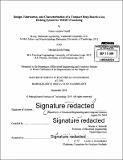Design, fabrication, and characterization of a compact deep reactive ion etching system for MEMS processing
Author(s)
Gould, Parker Andrew; Hsing, Mitchell David
DownloadFull printable version (26.41Mb)
Other Contributors
Massachusetts Institute of Technology. Department of Electrical Engineering and Computer Science.
Advisor
Martin A. Schmidt.
Terms of use
Metadata
Show full item recordAbstract
A general rule of thumb for new semiconductor fabrication facilities (Fabs) is that revenues from the first year of production must match the capital cost of building the fab itself. With modem Fabs routinely exceeding $1 billion to build, this rule serves as a significant barrier to entry for groups seeking to commercialize new semiconductor devices aimed at smaller market segments which require a dedicated process. To eliminate this cost barrier we are working to create a small-scale production suite of tools that will processes small (~1") substrates and cost less than $1 million. By shrinking the size of the substrate, substantial savings can be realized in material usage, energy consumption, and, most importantly, capital costs. In this thesis, we present the development of the first tool in this suite of small substrate processing equipment, a deep reactive ion etcher (DRIE). DRIE tools are used to create highly anisotropic, high aspect-ratio trenches in silicon-a crucial element in the production of many microelectromechanical systems (MEMS) devices. We are targeting the Bosch Process method of DRIE, which is a time multiplexed process that rapidly alternates between an SF₆-based reactive ion etching (RIE) step that isotropically etches silicon and a C₄F₈-based plasma-enhanced chemical vapor deposition (PECVD) step that passivates the sidewalls of the etched features. The rapid alternation between the RIE and PECVD steps allows highly anisotropic features to be etched in silicon. The DRIE system developed in this thesis is roughly the size of a microwave oven and costs just a fraction of commercial etching systems. The test results presented herein characterize the stability and operating limits of the vacuum and plasma generation systems, and demonstrate the system's raw etching capability using a mix of SF₆ and O₂ process gases. Etch rates exceeding 4 [mu]m/min with control of the etched profile are reported, with models fitted to the data indicating increased capabilities with optimized process conditions.
Description
Thesis: S.M., Massachusetts Institute of Technology, Department of Electrical Engineering and Computer Science, 2014. Cataloged from PDF version of thesis. Includes bibliographical references (pages 123-126).
Date issued
2014Department
Massachusetts Institute of Technology. Department of Electrical Engineering and Computer SciencePublisher
Massachusetts Institute of Technology
Keywords
Electrical Engineering and Computer Science.